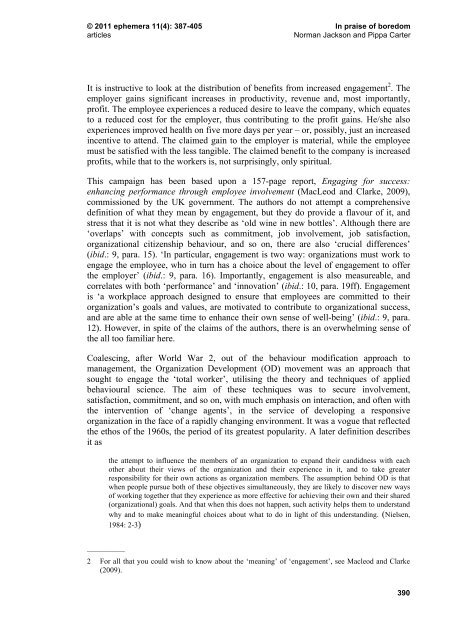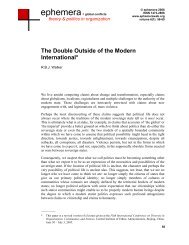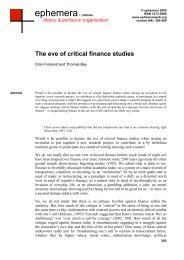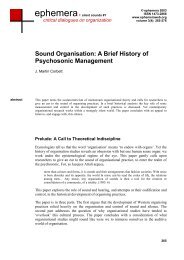Work, play and boredom - Ephemera
Work, play and boredom - Ephemera
Work, play and boredom - Ephemera
Create successful ePaper yourself
Turn your PDF publications into a flip-book with our unique Google optimized e-Paper software.
© 2011 ephemera 11(4): 387-405 In praise of <strong>boredom</strong><br />
articles Norman Jackson <strong>and</strong> Pippa Carter<br />
It is instructive to look at the distribution of benefits from increased engagement 2 . The<br />
employer gains significant increases in productivity, revenue <strong>and</strong>, most importantly,<br />
profit. The employee experiences a reduced desire to leave the company, which equates<br />
to a reduced cost for the employer, thus contributing to the profit gains. He/she also<br />
experiences improved health on five more days per year – or, possibly, just an increased<br />
incentive to attend. The claimed gain to the employer is material, while the employee<br />
must be satisfied with the less tangible. The claimed benefit to the company is increased<br />
profits, while that to the workers is, not surprisingly, only spiritual.<br />
This campaign has been based upon a 157-page report, Engaging for success:<br />
enhancing performance through employee involvement (MacLeod <strong>and</strong> Clarke, 2009),<br />
commissioned by the UK government. The authors do not attempt a comprehensive<br />
definition of what they mean by engagement, but they do provide a flavour of it, <strong>and</strong><br />
stress that it is not what they describe as ‘old wine in new bottles’. Although there are<br />
‘overlaps’ with concepts such as commitment, job involvement, job satisfaction,<br />
organizational citizenship behaviour, <strong>and</strong> so on, there are also ‘crucial differences’<br />
(ibid.: 9, para. 15). ‘In particular, engagement is two way: organizations must work to<br />
engage the employee, who in turn has a choice about the level of engagement to offer<br />
the employer’ (ibid.: 9, para. 16). Importantly, engagement is also measureable, <strong>and</strong><br />
correlates with both ‘performance’ <strong>and</strong> ‘innovation’ (ibid.: 10, para. 19ff). Engagement<br />
is ‘a workplace approach designed to ensure that employees are committed to their<br />
organization’s goals <strong>and</strong> values, are motivated to contribute to organizational success,<br />
<strong>and</strong> are able at the same time to enhance their own sense of well-being’ (ibid.: 9, para.<br />
12). However, in spite of the claims of the authors, there is an overwhelming sense of<br />
the all too familiar here.<br />
Coalescing, after World War 2, out of the behaviour modification approach to<br />
management, the Organization Development (OD) movement was an approach that<br />
sought to engage the ‘total worker’, utilising the theory <strong>and</strong> techniques of applied<br />
behavioural science. The aim of these techniques was to secure involvement,<br />
satisfaction, commitment, <strong>and</strong> so on, with much emphasis on interaction, <strong>and</strong> often with<br />
the intervention of ‘change agents’, in the service of developing a responsive<br />
organization in the face of a rapidly changing environment. It was a vogue that reflected<br />
the ethos of the 1960s, the period of its greatest popularity. A later definition describes<br />
it as<br />
__________<br />
the attempt to influence the members of an organization to exp<strong>and</strong> their c<strong>and</strong>idness with each<br />
other about their views of the organization <strong>and</strong> their experience in it, <strong>and</strong> to take greater<br />
responsibility for their own actions as organization members. The assumption behind OD is that<br />
when people pursue both of these objectives simultaneously, they are likely to discover new ways<br />
of working together that they experience as more effective for achieving their own <strong>and</strong> their shared<br />
(organizational) goals. And that when this does not happen, such activity helps them to underst<strong>and</strong><br />
why <strong>and</strong> to make meaningful choices about what to do in light of this underst<strong>and</strong>ing. (Nielsen,<br />
1984: 2-3)<br />
2 For all that you could wish to know about the ‘meaning’ of ‘engagement’, see Macleod <strong>and</strong> Clarke<br />
(2009).<br />
390








